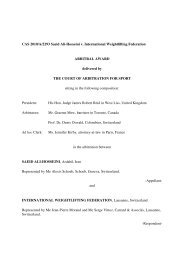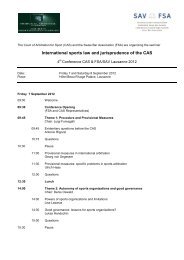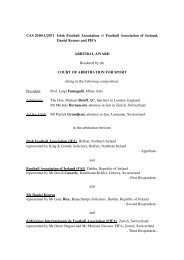(CAS) Bulletin - Tribunal Arbitral du Sport / TAS
(CAS) Bulletin - Tribunal Arbitral du Sport / TAS
(CAS) Bulletin - Tribunal Arbitral du Sport / TAS
Create successful ePaper yourself
Turn your PDF publications into a flip-book with our unique Google optimized e-Paper software.
C. Merits<br />
1. Applicable regulatory framework<br />
According to Article 21 UCI ADR “The following<br />
constitutes anti-doping rule violations:<br />
1. The presence of a Prohibited Substance or its Metabolites<br />
or Markers in a Rider’s bodily Specimen.<br />
1.1 It is each Rider’s personal <strong>du</strong>ty to ensure that no<br />
Prohibited Substance enters his body. Riders are<br />
responsible for any Prohibited Substance or its<br />
Metabolites or Markers found to be present in their<br />
bodily Specimens. Accordingly, it is not necessary<br />
that intent, fault, negligence or knowing Use on the<br />
Rider’s part be demonstrated in order to establish<br />
an anti-doping violation under article 21.1.<br />
Warning:<br />
1) Riders must refrain from using any substance,<br />
foodstuff, food supplement or drink of which<br />
they do not know the composition. It must be<br />
emphasized that the composition indicated on<br />
a pro<strong>du</strong>ct is not always complete. The pro<strong>du</strong>ct<br />
may contain Prohibited Substances not listed<br />
in the composition.<br />
2) Medical treatment is no excuse for using<br />
Prohibited Substances or Prohibited Methods,<br />
except where the rules governing Therapeutic<br />
Use Exemptions are complied with.<br />
1.2 Suffi cient proof of an anti-doping rule violation<br />
under article 21.1 is established by either of the<br />
following: presence of a Prohibited Substance or its<br />
Metabolites or Markers in the Rider’s A Sample<br />
where the Rider waives analysis of the B Sample<br />
and the B Sample is not analyzed; or, where the<br />
Rider’s B Sample is analyzed and the analysis of<br />
the Rider’s B Sample confi rms the presence of the<br />
Prohibited Substance or its Metabolites or Markers<br />
found in the Rider’s A Sample.<br />
1.3 Excepting those substances for which a quantitative<br />
threshold is specifi cally identifi ed in the Prohibited<br />
List, the presence of any quantity of a Prohibited<br />
Substance or its Metabolites or Markers in a<br />
Rider’s Sample shall constitute an anti-doping rule<br />
violation.<br />
1.4 As an exception to the general rule of article 21.1,<br />
the Prohibited List or International Standards<br />
may establish special criteria for the evaluation of<br />
Prohibited Substances that can also be pro<strong>du</strong>ced<br />
endogenously.<br />
1.5 The presence of a Prohibited Substance or its<br />
Metabolites or Markers consistent with the<br />
provisions of an applicable Therapeutic Use<br />
Exemption issued in accordance with the present<br />
Anti-Doping Rules shall not be considered an antidoping<br />
rule violation.<br />
2. (…)”<br />
On 21 July 2010, at the occasion of the second rest<br />
day of the 2010 Tour de France, following the 16 th<br />
stage, Mr Contador was subjected to a doping test and<br />
requested to fi le a urine sample. Both the A and B test<br />
results were positive for clenbuterol. Clenbuterol is a<br />
non-threshold prohibited substance that appears in<br />
Article S1.2 (other Anabolic Agent) of the 2010 WADA<br />
Prohibited List.<br />
Article 22 UCI ADR provides the following regarding<br />
the burden and standard of proof applicable to antidoping<br />
organisations in order to establish an antidoping<br />
rule violation:<br />
“ The UCI and its National Federations shall have the burden<br />
of establishing that an anti-doping rule violation has occurred.<br />
The standard of proof shall be whether the UCI or its National<br />
Federation has established an anti-doping rule violation to<br />
the comfortable satisfacstion of the hearing panel bearing in<br />
mind the seriousness of the allegation which is made. This<br />
standard of proof in all cases is greater than a mere balance<br />
of probability but less than proof beyond a reasonable doubt.<br />
Where these Anti-Doping Rules place the burden of proof upon<br />
the License-Holder alleged to have committed an anti-doping<br />
rule violation to rebut a presumption or establish specifi ed facts<br />
or circumstances, the standard of proof shall be by a balance of<br />
probability, except as provided in articles 295 and 305 where<br />
the License-Holder must satisfy a higher burden of proof ”.<br />
The Panel notes that Articles 295 (concerning the<br />
regime of elimination or re<strong>du</strong>ction of the period of<br />
ineligibility for specifi ed substances under specifi c<br />
circumstances) and 305 (aggravating circumstances)<br />
UCI ADR do not apply in the present matter.<br />
In his answer, Mr Contador states that “ in circumstances<br />
where the concentration of the Prohibited Substance is extremely<br />
low, as in this case, and deliberate use is ruled out, the presence<br />
of the Prohibited Substance alone is suffi cient to establish that<br />
an anti-doping rule violation has occurred ”.<br />
It is therefore undisputed that Mr Contador has<br />
committed an anti-doping rule violation and that the<br />
Appellants have met the standard of proof given the<br />
analytical reports made by the Cologne Laboratory<br />
and the confi rmation of the adverse analytical fi nding<br />
by the B Sample.<br />
Jurisprudence majeure / Leading cases<br />
-<br />
109





